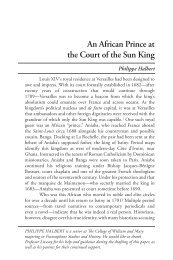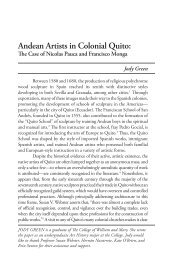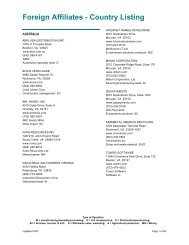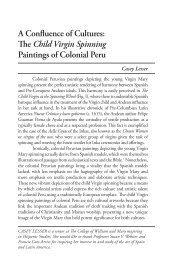Themes of Unity and Division in Beta Israel Identity Formation
Themes of Unity and Division in Beta Israel Identity Formation
Themes of Unity and Division in Beta Israel Identity Formation
You also want an ePaper? Increase the reach of your titles
YUMPU automatically turns print PDFs into web optimized ePapers that Google loves.
10 The Monitor - Summer 2010<br />
In these ways, both the Ethiopian Jews <strong>and</strong> the Christians<br />
contributed to the construction <strong>of</strong> a system <strong>of</strong> seem<strong>in</strong>gly impermeable<br />
boundaries <strong>and</strong> non-negotiable differences between the two groups.<br />
These dist<strong>in</strong>ctions were expressed <strong>in</strong> both abstract <strong>and</strong> concrete ways,<br />
from religious views to prohibitions on conversations <strong>and</strong> eye contact.<br />
When they played <strong>in</strong>to <strong>and</strong> emphasized these practices <strong>and</strong> beliefs<br />
that highlighted the schism between the <strong>Beta</strong> <strong>Israel</strong> <strong>and</strong> the Ethiopian<br />
Orthodox Church, Ethiopian Jews located themselves—as a coherent<br />
population—<strong>in</strong> opposition to the Christian “other,” thereby heighten<strong>in</strong>g<br />
their sense <strong>of</strong> <strong>in</strong>ternal group unity. Yet sometimes these boundaries were<br />
breached, similarities rather than differences were accentuated, <strong>and</strong> the<br />
rift between the communities did not seem so extreme. At these times,<br />
<strong>Beta</strong> <strong>Israel</strong> identity was determ<strong>in</strong>ed <strong>in</strong> an explicitly different way.<br />
<strong>Unity</strong> with Ethiopian Christians<br />
In many ways, Ethiopian Christianity <strong>and</strong> Ethiopian Judaism<br />
are more similar than they are different, <strong>and</strong> the <strong>Beta</strong> <strong>Israel</strong> have, at<br />
particular historical junctures, laid claim to these similarities rather<br />
than their differences from Ethiopian Christians. Their religious<br />
system developed <strong>in</strong> Ethiopia, without <strong>in</strong>put from Jewish groups <strong>of</strong><br />
other areas, <strong>and</strong> several scholars have argued that the religious practice<br />
<strong>of</strong> the <strong>Beta</strong> <strong>Israel</strong> resembles that <strong>of</strong> Ethiopian Orthodox Church more<br />
than it does that <strong>of</strong> globally recognizable Judaism. 27 Their religious<br />
leaders were referred to by the same terms, their prayer houses shared<br />
architectural similarities, they employed the same musical <strong>in</strong>struments<br />
<strong>in</strong> their services, <strong>and</strong> they celebrated similar life stage ceremonies. 28<br />
Both the Ethiopian Orthodox <strong>and</strong> the <strong>Beta</strong> <strong>Israel</strong> liturgical books<br />
are <strong>in</strong> Ge’ez, <strong>and</strong> are derived from the same sources. 29 To describe<br />
the commonalities between their belief systems would require nearendless<br />
space, but <strong>in</strong>cluded convictions as far-rang<strong>in</strong>g as the com<strong>in</strong>g<br />
<strong>of</strong> a messiah called Tewodros, <strong>in</strong>dividual immortality <strong>in</strong> the afterlife,<br />
<strong>and</strong> the existence <strong>of</strong> zar spirits which could possess <strong>in</strong>dividuals <strong>and</strong><br />
cause illness. 30<br />
Furthermore, the groups’ orig<strong>in</strong>s stories highlight further shared<br />
elements between the traditions. Ethipian Christians used the Kebra<br />
Negast, which told the story <strong>of</strong> Menilek I, as pro<strong>of</strong> that God had decided








